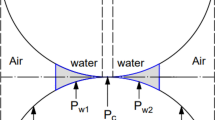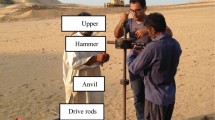Abstract
Shear strength parameters of soils C and \({\phi}\) can be determined by means of laboratory tests and in situ testing data. Common approaches for determination of soil strength parameters from CPT data are on the basis of bearing capacity and cavity expansion theories. A new method is proposed for C, \({\phi}\) prediction using all quantities, q c, u 2 and f s from CPTu considering bearing capacity mechanism of failure at cone tip and direct shear failure along the penetrometer sleeve. One advantage of this method is the improvement of accuracy in the case of erroneous data using all three outputs of CPTu. Laboratory test results, two sets of nonlinear equations by the proposed approach, and existing correlations of C and \({\phi}\) angle parameters have been compared by applying them on a data base compiled from six sources. In current methods, cohesive parameters are not considered in bearing capacity equation and they cause the failure loads to be transferred to the second part of the basic bearing capacity equation which is a function of the internal friction angel. It has been considered that the internal friction angle obtained by current methods is relatively higher than the measured values. Also, the comparison of predicted and measured C and \({\phi}\) angle values indicates good consistency and low scatter for the proposed method. Accordingly, this can lead to optimize design for geotechnical practice.

Similar content being viewed by others
References
Campanella R.G., Robertson P.K., Gillespie D.: Cone penetration testing in deltaic soils. Can. Geotech. J. 20(1), 23–35 (1983)
Lunne, T.; Robertson, P.K.; Powell, J.J.M.: Cone Penetration Testing in Geotechnical Practice, Blackie Acad, p. 312. Chapman and Hall/Routledge Press, London (1997)
Eslami A., Fellenius B.H.: CPT and CPTu data for soil profile interpretation: review of methods and a proposed new approach. Iran. J. Sci. Technol. Trans. B 28(B1), 69–86 (2004)
Tavenas, F.; Leroueil, S.: State of the art on laboratory and insitu stress–strain-time behavior of soft clay. In: Proceedings of the International Symposium on Geotechnical Engineering of Soft Soils, Mexico City vol. 2, pp. 69–113 (1987)
Senneset, K.; Janbu, N.: Shear strength parameters obtained from static cone penetration tests. Strength Testing of Marine Sediments; Laboratory and In Situ Measurement, ASTM Special technical publication, STP, vol. 883, pp. 41–54 (1985)
Mitchell J.K., Lunne T.A.: Cone resistance as measure of sand strength. J. Geotech. Eng. Div. ASCE 104(GT7), 995–1012 (1978)
Janbu, N.; Senneset, K.: Effective stress interpretation of in situ static penetration tests. In: Proceedings of the European Symposium on Penetration Testing, ESOPT, Stockholm, vol. 2, Part. 2, pp. 181–193 (1974)
Durgunglu, H.T.: Penetration tests of cohesion soils. In: Proceedings, ASCE, Speciality Conference on In-Situ Measurements of Soil Parameters, Raleigh, vol. 1 (1975)
Vesic A.S.: Expansion of cavities in infinite soil mass. J. Soil Mech. Found. Div. ASCE 98(3), 265–290 (1972)
Hight, D.W.; Paul, M.A.; Barras, B.F.; Powell, J.J.M.; Nash, D.F.T.; Smith, P.R.; Jardine, R.J.; Edwards, D.H: The characterization of the Bothkennar clay. In: International Workshop on Characterisation and Engineering Properties of natural soils, Dec 2-4, Singapore, Balkema, vol. 1, pp. 543–597 (2003)
Meyerhof G.G.: Scale effects of ultimate pile capacity. J. Geotech. Eng. Div. ASCE 109(5), 797–806 (1983)
Cai G.J., Liu S.Y., Tong L.Y., Du G.Y.: Field evaluation of undrained shear strength from piezocone penetration tests in soft marine clay. Marine Georesour. Geotechnol. 28(2), 143–153 (2010)
Eslami A., Fellenius B.H.: Pile capacity by direct CPT and CPTu methods applied to 102 case histories. Can. Geotech. J. 34(5), 886–904 (1997)
Jamiolkowski, M.; Robertson, P.K.: Closing address: future trends for penetration testing. In: Geotechnology Conference Penetration Testing in UK, Birmingham, pp. 321–342 (1988)
Ahmadi, M.M.; Karambakhsh, P.: K0 determination of sand using CPT calibration chamber. In: 2nd International Symposium on Cone Penetration Testing, Huntington Beach, CA, USA, vol. 2 and 3: Technical Papers, Session 2: Interpretation, Paper No. 14 (2010)
Maple: Maplesoft, A Division of Waterloo Maple Inc., Waterloo (1981–2010)
Mandro: Consulting Engineers Final Report: Site Investigation and Geotechnical Survey for Narenjestan Hotel Babolsar located in Southern Caspian Sea, North of Iran (2012)
Mazandaran Soil Mechanics Laboratory Consulting Engineers, Final Report: Site Investigation and Geotechnical Survey for Behshahr located in Southern Caspian Sea, North of Iran, Rep. No. 3267.1 (2012)
Sham-e Consulting Engineers, Final Report: Site Investigation and Geotechnical Survey for Narges Hotel sari located in Southern Caspian Sea, North of Iran, Rep. No. 1276.32 (2012)
Na Y.M., Choa V., The C.I., Chang M.F.: Geotechnical parameters of reclaimed sandfill from the cone penetration test. Can. Geotech. J. 42(1), 91–109 (2005)
Briaud J.L., Gibbens R.M.: Behavior of five large spread footing in sand. J. Geotech. Geoenviron. Eng. 125(9), 787–796 (1999)
Robertson P.K., Woeller D.J., Finno W.D.L.: Seismic cone penetration test for evaluating liquefaction potential under cyclic loading. Can. Geotech. J. 29(4), 686–695 (1992)
Meyerhof G.G.: Ultimate bearing capacity of footings on sand layer overlying clay. Can. Geotech. J. 11(2), 223–229 (1974)
Muromachi, T.: Experimental study on application of static cone penetrometer to subsurface investigation of weak cohsive Soils. Railway Technical Research Japanese National Railway, pp. 285–291 (1972)
Schmertmann, J.H.: Guidelines for cone penetration test (performance and design), Final Report No. FHWA-TS-78-209 (1978)
Mitchell J.K., Durgunoglu H.T.: Cone resistance as measure of sand strength. J. Geotech. Eng. Div. ASCE 104(GT7), 995–1012 (1983)
Robertson, P. K.; Campanella, R. G.: Guidelines for geotechnical design using CPT and CPTU. Soil Mechanics Series No. 120 (1988)
Mayne P. W., Kulhawy F. H.: Discussion: Relationship between K0 and overconsolidation ratio: a theoretical approach. Geotechnique 53, 450–454 (2003)
Senneset, K.; Janbu, N.; Svano, G.: Strength and deformation parameters from cone penetration tests. In: Proceedings of the Second European Symposium on Penetration Testing, pp. 24–27 (1982)
Senneset, K.; Sandven, R.; Lunne, T.; By, T.; Amundsen, T.: Piezocone tests in silty soils. In: Penetration Testing 1988, vol. 2, pp. 955–974 (1988)
Author information
Authors and Affiliations
Corresponding author
Rights and permissions
About this article
Cite this article
Motaghedi, H., Eslami, A. Analytical Approach for Determination of Soil Shear Strength Parameters from CPT and CPTu Data. Arab J Sci Eng 39, 4363–4376 (2014). https://doi.org/10.1007/s13369-014-1022-x
Received:
Accepted:
Published:
Issue Date:
DOI: https://doi.org/10.1007/s13369-014-1022-x




